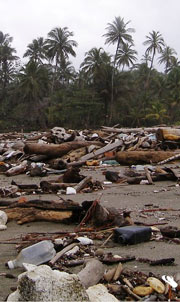Plastic- an invention no one can live without.
"Plastic" simply describes the property of being able to form or mold. When we use the term plastic, we tend to think of the hydrocarbon plastics used in the manufacture of just about everything these days from kitchenware to organ implants. The problem is these materials are chemically persistent, and have accumulated to toxic levels in our rivers, streams, oceans, landfills, and our life forms, our bodies.
Edutainment
Everybody Look What's Goin' DownThere's somethin happenin here. Original file location: http://youtu.be/Ta8HaHP_9rE |
Sea Captain Charles Moore of Algalita Marine Foundation“Plastic resin pellets (“nurdles”) absorb and concentrate toxins such as PCB & DDE up to 1 MILLION times their level in ambient sea water.” Original video link: http://youtu.be/XxNqzAHGXvs |
Plastic IslandIs this a new island resort? Original file found at: http://youtu.be/FTurihxSTnI
|
What's the Problem with Fossil Plastics?
Hydrocarbon plastics are made from numerous petroleum based chemicals and additives. Many of these have been proven to be carcinogenic, and have other harmful effects on the balance of animal life. The persistence of the chemical make-up of these compounds cause the products made from them to become a non-biodegradable "blanket" which is now so pervasive in our environment that it is suffocating, strangling, and starving the animal life on this planet.
One startling statistic by a Southern California research project cites there is "six times more plastic than plankton floating in the North Pacific". Are you aware of the massive amounts of garbage dumped into the oceans?
In general, consumers believe that products they come into contact with are safe to use, and approved by some government agencies. This is not true at all. For instance, despite knowing that PVC is a carcinogen since 1970, we are still producing and using massive amounts of this compound for household use, and billions of pounds of PVC are being thrown away in the US each year.
Don't be fooled by recycling- Recycling has been a weak solution.
In reality most plastics are very difficult to recycle and are not usually recycled into the same type of product that they were collected from, if they are recycled at all. The polymer chains of hydrocarbon plastics break down each time they are melted, making them less useful or reliable for plastic bottles for instance. Many consumers falsely believe that this material is being recycled into the same products they recycle, which isn't so. The increasing demand for plastic containers (13 billion pounds in the US in 2004) demands the use and manufacture of virgin hydrocarbon plastics. We are not stopping the toxic spill through recycling. There is increasing demand, and increasing production.
In addition, recycling efforts in voluntary states is ineffective, causing most plastics used there to go directly to landfill. Go to Container Recycling Institute's study on the downward trend of consumer recycling.
So how can we stop the problem?
We must realize that there is no safe place for this toxic bio-accumulation to be sequestered, and we are still increasing production of hydrocarbon plastics at a rate of about 80 billion pounds per year through the manufacture of virgin plastics for bottles, plastic bags, packaging, and every other application that our current lifestyle demands. We need smarter science, and more modest lifestyles.
Making Smarter Plastics
'Hydrocarbon' (molecules from petroleum) and 'carbohydrate' (a molecule from plants) sound alike, because they are. Both are 'polymers' - large molecules made from combining smaller molecules made of carbon-and-hydrogen chains. "Polymer materials have been designed in the past to resist degradation. The challenge is to design polymers that have the necessary functionality during use, but destruct under the stimulus of an environmental trigger after use. Designing plastics used in single-use disposable packaging and consumer goods to be biodegradable and ensuring that they end up in composting systems is environmentally and ecologically sound. This can be done using carbohydrates as the source of the polymers that make up the plastic material." See " Compostable Plastics & Role of Composting in Waste Management & Sustainable Agriculture" by professor Ramani Narayan. ( Also see from the University of Minnesota more information on starch-based plastics.)
What are Green Plastics?
Green plastics are plastics made from renewable, benign, compostable material. "Carbohydrate material (from plants) is more plentiful in the biosphere than all other organic matter combined�(they are) agricultural feedstocks that could provide a large sustainable source of biodegradable plastics materials" says E. S. Stevens of Binghamton University. Professor Stevens wrote a series of articles for BioCycle Magazine. He is also the author of Green Plastics.
There are now several major manufacturers of benign biopolymer resins which can substitute for the toxic predecessors. These resins are beginning to be introduced in their most practical applications, like plastic grocery bags and food service plates and utensils, and perishable product packaging.
How we can all make a change:
Replace hydrocarbon plastics with compostable materials for our daily living ......Buy Green Plastics
Enact government legislation to phase out the use of toxic, pervasive compounds .......Advocate for change
Education on hydrocarbon plastics and biopolymer substitution :
From IENICA ( Interactive European Network for Industrial Crops and their Applications) A series of white papers on Bioplastics
Learn how and where to find certified green plastics:
US: Biodegradable Plastics Institute
European Union: DIN Certco Certification
Japan: Japan Bioplastics Associations (JBPA)

